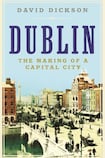
When such a scholarly, encyclopaedic exploration of our capital city as this highly readable new study by David Dickson is published, one benedictionthe reader may feel is about to be bestowed upon them is that, because Dickson's narrative ends on the cusp of the millennium, in 2000, we will be spared all references to that most cursed expression: "the troika".
Sadly, however, it seems that, like taxes, the poor and Shelbourne Football Club, troikas have always been with us. But Dublin’s original troika – its clique of three Protestant politicians who formed a late-18th-century inner “castle cabinet” – left behind a grander, more lasting physical legacy than our recently departed troika of the EU, the ECB and the IMF.
Buildings such as Dublin's magnificent Custom House (although contentious and not without its share of grubby political shenanigans at planning stage) were built in this period, under the watch of the most influential, well-connected member of that troika: John Beresford (1738-1805).
In a wonderful irony of history, Bertie Ahern, the taoiseach whose reckless policies did most to cause the more recent troika to tie up their longboats on the Liffey and tie up our economy in austerity, lives in an estate named after the Beresford family.
In a further irony, the land on which Beresford Estate is built was until recently owned by All Hallows College, which is closing amid a welter of controversies. All Hallows’ original opening as a seminary, in 1842, highlighted the huge sea change in political and religious influence that occurred in Dublin in the 37 years after John Beresford’s death: by then Daniel O’Connell was Dublin’s first Catholic lord mayor.
Part of the joy in Dickson’s panoramic overview of Dublin’s evolution since the marshy Liffey banks were first inhabited is being able to form a clear picture of this pattern of juxtapositions, contradictions, convergences and continuations that have contributed to the city’s physical landscape and to the political and social concept of what constitutes Dublin.
The city is fortunate in not having been built on water, like Venice, or on sand, like Amsterdam. Otherwise its foundations would have sunk by now under the weight of the books written in recent years about aspects of its history. These range from amateur labours of love, such as Drumcondra and Its Environs, by Louis O'Flaherty (self-published but to the highest production standards), to books as professionally researched and detailed as Ruth McManus's magnificent Dublin, 1910-1940: Shaping the City and Suburbs or Douglas Bennett's The Encyclopaedia of Dublin.
Dickson's Dublin is a magnificent work of scholarship in its own right, delving into archives and records, but he remains cognisant of the ongoing growth in research elsewhere. He therefore presents his overview as "a report of work (of many people's work) in progress", which draws on the current proliferation of academic research "to present a synthesis of our understanding of the elevation of the city".
The fact that his bibliographical notes stretch across 14 pages and his index lasts for 48 gives some sense of the scale of the scholarship condensed into this single volume and of the multiplicities of Dublins revealed, like rings concealed in a tree trunk.
These range from the Icarus-like, delusional giddiness of the incipient Celtic Tiger years right back to when Dublin was merely a gravel ridge amid the currents of the Liffey estuary, serving as a meeting place for travellers, fishermen and farmers.
Extraordinary amount has survived
Much of Dickson’s analysis of 20th-century Dublin’s development will be familiar to readers. But when you re-encounter comments by influential figures such as John Charles McQuaid’s favoured architect,
John Robinson
, who advocated tearing down the great terraces around Merrion Square to build a Catholic cathedral in its centre – “the Georgian era is over . . . Nothing is left for them but demolition” – you realise that the extraordinary fact is not that so much of Dublin’s heritage was destroyed but that so much survived.
However, it is in his reincarnations of earlier Dublins, less familiar to this reader, that Dickson's book comes into its own. He brilliantly captures the idealistic but hopelessly muddled insurrectionist plans of Robert Emmet. He provides a concise account of the rapidly forged (and rapidly broken) alliances of convenience and the double dealings of various factions jostling for advantage in the events surrounding the Battle of Clontarf. He superbly re-creates the tight-knit streets of Viking Dublin and the casual street violence along the affluent squares of Grattan's Dublin – a world where pistols and blunderbusses were so easily attainable that the US National Rifle Association would have felt at home.
The main pleasure of this book is that its remit is not corralled by architecture or politics or social conditions. Along with these are accounts of great novels such as Ulysses, side by side with the popular magazines that Gerty MacDowell would have loved. Dickson conjures up the arrival of cinema; the propensities of domestic servants; the apothecaries and proselytisers, the revolutionaries and Guinness workers; the influx of Jews and Huguenots and more recent arrivals that keep Dublin evolving as an ever-expanding, often exasperating and always fascinating city. Novelists, historians and general readers will plunder this cornucopia for years to come.
A clothbound limited edition is available for €125 from lilliputpress.ie











